Trade books published for readers of all ages offer engaging and insightful—and sometimes surprising—perspectives on topics that have cross-curricular connections. The imaginative books in this week’s column incite interest and raise questions about important subjects—from space science to species extinction and recycling—making them good choices for reading for pleasure and for knowledge.
Ages 4–8
Can an Aardvark Bark? Melissa Stewart. Ill. Steve Jenkins. 2017. Beach Lane/Simon & Schuster.
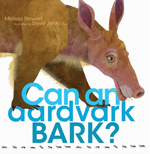 In Stewart and Jenkins’ playful exploration of the vocalizations of animals, patterned questions and responses—“Can an aardvark bark?” No, but it can grunt.”—are paired with textured torn and cut paper collage portraits of the animals. Each Q&A double-page spread is followed by a double-spread presenting four other animals that make the same sound. The final page is an invitation for children to identify the seven featured animals (aardvark, seal, wild boar, porcupine, dingo, giraffe, and kangaroo) and to mimic their sounds: grunt, growl, squeal, laugh, bellow, bark, and whine. Back matter includes selected sources and books for further reading.
In Stewart and Jenkins’ playful exploration of the vocalizations of animals, patterned questions and responses—“Can an aardvark bark?” No, but it can grunt.”—are paired with textured torn and cut paper collage portraits of the animals. Each Q&A double-page spread is followed by a double-spread presenting four other animals that make the same sound. The final page is an invitation for children to identify the seven featured animals (aardvark, seal, wild boar, porcupine, dingo, giraffe, and kangaroo) and to mimic their sounds: grunt, growl, squeal, laugh, bellow, bark, and whine. Back matter includes selected sources and books for further reading.
—CA
Listen: How Pete Seeger Got America Singing. Leda Schubert. Ill. Raúl Colón. 2017. Neal Porter/Roaring Brook.
 This picture book biography celebrates the life and work of Pete Seeger (1919–2014), who, through his music and activism “got America singing.” Schubert deftly weaves the titles of a host of original and traditional songs (printed in blue) that Seeger sang with audiences into the spare, expressive text of this tribute to an American hero who “cared about justice, peace, equality, and people everywhere.” Colón’s watercolor and colored pencil illustrations show the joy of the experiences Seeger shared with friends and gatherings of people of all ages. Back matter includes an author’s note, a timeline of significant events in Seeger’s life, sources of direct quotes, a selected bibliography, a list of books for children, and recommended recordings.
This picture book biography celebrates the life and work of Pete Seeger (1919–2014), who, through his music and activism “got America singing.” Schubert deftly weaves the titles of a host of original and traditional songs (printed in blue) that Seeger sang with audiences into the spare, expressive text of this tribute to an American hero who “cared about justice, peace, equality, and people everywhere.” Colón’s watercolor and colored pencil illustrations show the joy of the experiences Seeger shared with friends and gatherings of people of all ages. Back matter includes an author’s note, a timeline of significant events in Seeger’s life, sources of direct quotes, a selected bibliography, a list of books for children, and recommended recordings.
—CA
This Is How We Do It: One Day in the Lives of Seven Kids from Around the World. Matt Lamothe. 2017. Chronicle.
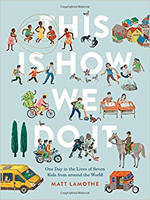 Boys from Italy, Uganda, Iran, Russia, and Peru, and girls from India and Japan share their daily routines, including what they wear to school, how they get to school, the food they eat, their household chores, and their favorite games. Lamothe’s digitally-rendered drawings (based on photographs provided by the children’s families) in individual panels on double-page spreads show, at times, what they have in common and, at other times, how they are different. Back matter includes photographs of the families, a glossary, and an author’s note. A world map on the endpapers shows where the children live.
Boys from Italy, Uganda, Iran, Russia, and Peru, and girls from India and Japan share their daily routines, including what they wear to school, how they get to school, the food they eat, their household chores, and their favorite games. Lamothe’s digitally-rendered drawings (based on photographs provided by the children’s families) in individual panels on double-page spreads show, at times, what they have in common and, at other times, how they are different. Back matter includes photographs of the families, a glossary, and an author’s note. A world map on the endpapers shows where the children live.
—SW
Ages 9–11
Bertha Takes a Drive: How the Benz Automobile Changed the World. Jan Adkins. 2017. Charlesbridge.
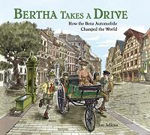 It is 1888 and Bertha Benz’s husband, Karl, has invited the first Benz Motorwagen to visit her mother. she and her two sons had to sneak out of their house before dawn. Driving the motorwagen, which was considered a danger on the streets, was illegal in Germany. Driving over rutted and dusty roads caused problems with the car, but unflustered and undaunted, Bertha resourcefully invented solutions, such as using her hat pin to open the fuel line and a rubber garter to wrap around frayed electric wiring. She invented brake pads by having a cobbler put leather strips on the wood brakes so they would hold against the tires. Adkins' illustrations depict the challenging 100-kilometer cross-country road trip. An “Automobile Evolution” timeline, a labeled diagram of the Benz Motorwagen III, and Adkins’ author’s note explaining his research process help readers understand the period, the car, and the driver.
It is 1888 and Bertha Benz’s husband, Karl, has invited the first Benz Motorwagen to visit her mother. she and her two sons had to sneak out of their house before dawn. Driving the motorwagen, which was considered a danger on the streets, was illegal in Germany. Driving over rutted and dusty roads caused problems with the car, but unflustered and undaunted, Bertha resourcefully invented solutions, such as using her hat pin to open the fuel line and a rubber garter to wrap around frayed electric wiring. She invented brake pads by having a cobbler put leather strips on the wood brakes so they would hold against the tires. Adkins' illustrations depict the challenging 100-kilometer cross-country road trip. An “Automobile Evolution” timeline, a labeled diagram of the Benz Motorwagen III, and Adkins’ author’s note explaining his research process help readers understand the period, the car, and the driver.
—SW
Exploring Space: From Galileo to the Mars Rover and Beyond. Martin Jenkins. Ill. Stephen Biesty. 2017. Candlewick.
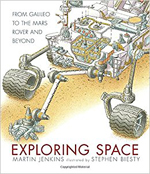 Voyager 1, the most distant man-made object in outer space, the evolution of the telescope, and possible future habitats on Mars are among the topics of space science depicted in intricate pencil and colored pencil drawings in this survey book on space exploration. This beautifully designed large-format book provides detailed information about exploratory projects such as the Mars Landing and Rover, satellites to support human communities living in outer space, and modes of travel outside of Earth’s gravity. The back matter includes a “Discovering Space” timeline, a glossary, and selected resources.
Voyager 1, the most distant man-made object in outer space, the evolution of the telescope, and possible future habitats on Mars are among the topics of space science depicted in intricate pencil and colored pencil drawings in this survey book on space exploration. This beautifully designed large-format book provides detailed information about exploratory projects such as the Mars Landing and Rover, satellites to support human communities living in outer space, and modes of travel outside of Earth’s gravity. The back matter includes a “Discovering Space” timeline, a glossary, and selected resources.
—SW
Puritan Girl, Mohawk Girl. John Demos. 2017. Amulet/Abrams.
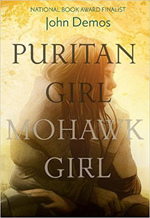 In the preface to this historical novel, based on his The Unredeemed Captive: A Family Story from Early America (1994), Demos provides context for the story of Eunice Williams, an 8-year-old Puritan girl who was kidnapped by Mohawks in a raid on her town of Deerfield, in the Massachusetts colony, in the winter of 1704. Having survived the 200-mile trek north into Canada during the bitter winter, Eunice is adopted into a Mohawk family living in a village near the St. Lawrence River. She is given a Mohawk name, A’ongote. Over the years, she accepts Mohawk beliefs and customs, and she chooses to stay with them throughout her life. Demos’ presentation of the story from the perspective of this captive Puritan girl who became a Mohawk makes this an accessible narrative history for young readers. Back matter includes an author’s note, source notes, and a selected bibliography.
In the preface to this historical novel, based on his The Unredeemed Captive: A Family Story from Early America (1994), Demos provides context for the story of Eunice Williams, an 8-year-old Puritan girl who was kidnapped by Mohawks in a raid on her town of Deerfield, in the Massachusetts colony, in the winter of 1704. Having survived the 200-mile trek north into Canada during the bitter winter, Eunice is adopted into a Mohawk family living in a village near the St. Lawrence River. She is given a Mohawk name, A’ongote. Over the years, she accepts Mohawk beliefs and customs, and she chooses to stay with them throughout her life. Demos’ presentation of the story from the perspective of this captive Puritan girl who became a Mohawk makes this an accessible narrative history for young readers. Back matter includes an author’s note, source notes, and a selected bibliography.
—CA
This Book Stinks!: Gross Garbage, Rotten Rubbish, and the Science of Trash. Sarah Wassner Flynn. 2017. National Geographic Kids.
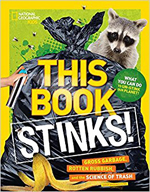 Sleeping bags from recycled water bottles, stylish dresses from discarded CDs and newspapers, waste bins on wheels with sensors to track and catch thrown trash—these are just a few examples of the possible future of trash that this survey book describes. A chapter on “Trashing the Earth” covers topics such as the location of the biggest dumps and landfills around the world, the islands of garbage that float on every ocean of the Earth, and waste in outer space. Alarming photographs and statistics (e.g., “5 trillion pieces of plastic are floating in the world’s seas”) show the magnitude of the global problem of dealing with the trash humans generate from the smallest food scraps to cars and refrigerators. The format of This Book Stinks grabs the reader’s attention. Each chapter includes features such as special reports, infographics, quizzes, jokes, factoids, and full-color, captioned photographs. The book concludes with a wealth of actions readers can take to manage and reuse their trash to help “un-stink” our planet.
Sleeping bags from recycled water bottles, stylish dresses from discarded CDs and newspapers, waste bins on wheels with sensors to track and catch thrown trash—these are just a few examples of the possible future of trash that this survey book describes. A chapter on “Trashing the Earth” covers topics such as the location of the biggest dumps and landfills around the world, the islands of garbage that float on every ocean of the Earth, and waste in outer space. Alarming photographs and statistics (e.g., “5 trillion pieces of plastic are floating in the world’s seas”) show the magnitude of the global problem of dealing with the trash humans generate from the smallest food scraps to cars and refrigerators. The format of This Book Stinks grabs the reader’s attention. Each chapter includes features such as special reports, infographics, quizzes, jokes, factoids, and full-color, captioned photographs. The book concludes with a wealth of actions readers can take to manage and reuse their trash to help “un-stink” our planet.
—SW
Ages 12–14
The Great American Foot Race: Ballyhoo for the Bunion Derby! Andrew Speno. 2017. Calkins Creek/Highlights.
 At the height of the Roaring Twenties, and in a period of growing interest in recreational sports, C. C. Pyle promoted a transcontinental foot race. The race coincided with the Good Roads Movement advocating the construction of national highways. Pyle planned the 1928 foot race from Los Angeles to Chicago along what would become U.S. Route 66, and then onto New York City with scheduled stops to rest, eat, and sleep. Raising funds along the way and securing provisions and accommodations for the runners were bigger problems than he anticipated. Speno weaves biographical remarks about some of the participants into the chronicle of the dramatic and often harrowing events of the 84-day race. Archival illustrations, photographs, maps, and charts of race results add interest.
At the height of the Roaring Twenties, and in a period of growing interest in recreational sports, C. C. Pyle promoted a transcontinental foot race. The race coincided with the Good Roads Movement advocating the construction of national highways. Pyle planned the 1928 foot race from Los Angeles to Chicago along what would become U.S. Route 66, and then onto New York City with scheduled stops to rest, eat, and sleep. Raising funds along the way and securing provisions and accommodations for the runners were bigger problems than he anticipated. Speno weaves biographical remarks about some of the participants into the chronicle of the dramatic and often harrowing events of the 84-day race. Archival illustrations, photographs, maps, and charts of race results add interest.
—SW
The New Ocean: The Fate of Life in a Changing Sea. Bryan Barnard. 2017. Alfred A. Knopf/Random House.
 This book tells the stories of six sea dwellers: jellyfish, orcas, sea turtles, tuna, corals, and blue-green algae. A description of the life cycle, habitats, and eating patterns of each of six ocean dwellers is followed by a consideration of the sequence of events that has led to the dominance of some species, like the jellyfish and blue-green algae, and the decline of others. Each species is depicted in an oil painting, with a second illustration that shows how changes in the food chain and water temperature affect survival rates. “An Ocean of Plastic” map on the front endpaper shows the circulation of “garbage patches” by ocean currents, and a map on the back endpaper depicts how the absorption of heat and atmospheric carbon dioxide by the oceans is making the water hotter and more acidic and bleaching coral reefs around the world.
This book tells the stories of six sea dwellers: jellyfish, orcas, sea turtles, tuna, corals, and blue-green algae. A description of the life cycle, habitats, and eating patterns of each of six ocean dwellers is followed by a consideration of the sequence of events that has led to the dominance of some species, like the jellyfish and blue-green algae, and the decline of others. Each species is depicted in an oil painting, with a second illustration that shows how changes in the food chain and water temperature affect survival rates. “An Ocean of Plastic” map on the front endpaper shows the circulation of “garbage patches” by ocean currents, and a map on the back endpaper depicts how the absorption of heat and atmospheric carbon dioxide by the oceans is making the water hotter and more acidic and bleaching coral reefs around the world.
—SW
Ages 15+
Soldier Boy. Kelly Hutton. 2017. Farrar Straus Giroux.
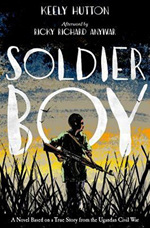 In an author’s note at the beginning of the book, Hutton provides information on her interviews with Ricky Richard Anywar, a former “soldier boy,” and research about the Ugandan civil war and Joseph Kony’s Lord’s Resistance Army (LRA) to prepare readers for this biographical novel of a child soldier. In 1989, at age 14, Ricky was abducted by Joseph Kony’s rebel army during a raid in his village. Hutton gives a vivid account of the brutal training and horrors of the combat missions that Ricky endured and survived (which most child soldiers did not) over four years, while he remained determined to escape and return home. Interwoven into the narrative are chapters set in 2006 in which fictional 11-year-old Samuel, who is recuperating from battlefield wounds, distrusts his caregivers and the stranger who promises to help him get home. An afterword by Anywar provides information about the challenges and reality of life faced by former child soldiers and the work of Friends of Orphans, a charity helping them to recover from their past, with hope for a brighter future in Uganda.
In an author’s note at the beginning of the book, Hutton provides information on her interviews with Ricky Richard Anywar, a former “soldier boy,” and research about the Ugandan civil war and Joseph Kony’s Lord’s Resistance Army (LRA) to prepare readers for this biographical novel of a child soldier. In 1989, at age 14, Ricky was abducted by Joseph Kony’s rebel army during a raid in his village. Hutton gives a vivid account of the brutal training and horrors of the combat missions that Ricky endured and survived (which most child soldiers did not) over four years, while he remained determined to escape and return home. Interwoven into the narrative are chapters set in 2006 in which fictional 11-year-old Samuel, who is recuperating from battlefield wounds, distrusts his caregivers and the stranger who promises to help him get home. An afterword by Anywar provides information about the challenges and reality of life faced by former child soldiers and the work of Friends of Orphans, a charity helping them to recover from their past, with hope for a brighter future in Uganda.
—CA
Sandip LeeAnne Wilson serves as professor in the School of Education and the English Department of Husson University, Bangor, Maine. Carolyn Angus is former Director of the George G. Stone Center for Children's Books, Claremont Graduate University, in Claremont, California.